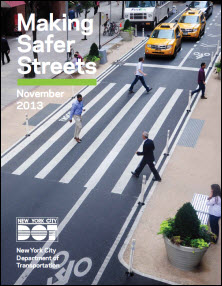 New York City Department of Transportation (NYCDOT) released the report "Making Safer Streets." The report uses before-and-after comparisons of crash data for "smart and innovative" street improvement projects intended to create "Complete Streets," implemented between 2007-13. The projects analyzed range from road diets, installation of bicycle lanes, pedestrian refuge medians, curb bulb-outs and small plazas, roadway closings, tightened intersection design, crosswalk installations, and signal timing adjustments, among others. When comparing three years of "before" data with two to three years of "after" data, researchers found that injury crashes at individual project sites were reduced by anywhere from 12 percent to 88 percent.
New York City Department of Transportation (NYCDOT) released the report "Making Safer Streets." The report uses before-and-after comparisons of crash data for "smart and innovative" street improvement projects intended to create "Complete Streets," implemented between 2007-13. The projects analyzed range from road diets, installation of bicycle lanes, pedestrian refuge medians, curb bulb-outs and small plazas, roadway closings, tightened intersection design, crosswalk installations, and signal timing adjustments, among others. When comparing three years of "before" data with two to three years of "after" data, researchers found that injury crashes at individual project sites were reduced by anywhere from 12 percent to 88 percent.
The report includes before-and-after design renderings to illustrate its five basic rules for street safety:
- Make the street easy to use (accommodate desire lines and minimize route complexity for users of all modes).
- Create safety in numbers (provide adequate, well-defined space for pedestrians and cyclists and use signal timing to create platoons or groups of cars with gaps in between).
- Make the invisible visible (put people using all modes in positions they "must" see each other).
- Quality over quantity (fewer and/or narrower well-functioning travel lanes is better than a greater number poorly functioning lanes, and can allow other elements to benefit all users).
- Look beyond the problem (expanding the focus area or project limits can unlock).